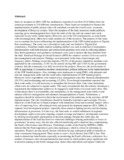| dc.description.abstract | Since its inception in 2003, CDF has facilitated a transfer of over Ksh.33.25 billion from the central government to 210 different constituencies. These funds are earmarked to finance the implementation of public projects that will contribute towards the overall socio- economic development of Kenya as country. Since the inception of the fund, numerous media publicity exposing gross mismanagement have been the order of the day and one cannot miss such exposures in any weeks media reports. However, out of the 210 constituencies, as some battle with mismanagement, others have made prudent use of the resources. The purpose of this study was to examine the factors influencing the implementation of the CDF funded projects in Tigania East constituency.
The study was a descriptive study and was limited to Tigania East constituency. Stratified simple random sampling method was used in selection of respondents. Questionnaires with both structure and unstructured questions were used in collecting primary data. Both quantitative and qualitative techniques were used to analyze the data obtained from the field. Statistical Package for Social Sciences (SPSS for windows version 15.0) was used in data management and analysis. Findings were presented in the form of percentages and frequency tables. Findings reveal that majority (58.2%) of the project committee members were appointed by the community, 21.8% by the current serving MP, and 13.6% by the government evidence that the community was fully involved in the projects.
However, the involvement of MPs in appointing of committee members demonstrates political influence in the implementation of the CDF funded projects. Also, trainings were inadequate to equip PMCs with adequate and relevant management skills and this could affect implementation of CDF funded projects. Moreover, fewer respondents were trained in key management areas like financial administration (29.27%) and bookkeeping and accounting (12.20%). Even though respondents reported that there were audits, it is still necessary to strengthen this because there were some institutions which were not subjected to regular audits.
This study recommends that the ministry should put a requirement that independent auditors to be engaged to audit books of account more often. This would ensure there is accountability and transparency in the management team which would enhance effective management and minimize misappropriation of funds. Furthermore, a regulation should be enforced to block the involvement of the politicians in the activities ofCDF implementation. The role of politicians should be limited to legislative and oversight. The key objectives of the Fund are to finance projects with immediate social and economic impact with a view of improving lives, alleviating poverty and general development purposes (lEA, 2006). It supports local development projects, especially those aimed at fighting poverty and developing infrastructure at grassroots. It is this way, the fund seeks to control imbalances in regional development, improve pro-poor targeting, expand coverage and improve development outcomes by eliciting local people's participation in decision making.
Despite this noble idea, the implementation of the fund has however witnessed challenges relating particularly to issues of governance. In many ways, this has also affected monitoring and evaluation thus compromising the Fund's effectiveness and efficiency. Preliminary results of the Fund by KIPPRA (2006) indicate that the Fund experiences gross data inadequacy which is critical in informing its operations. Projects are also poorly chosen with those having widespread spillover benefits to some constituents being ignored. There seems to exist a 'fiscal illusion' that CDF is free. This tends to demotivate beneficiaries especially in monitoring the Fund's efficiency utilization. In a number of instances clear documentation has been noted in which politics playa significant role in decision making in the Fund's management. Quite often individuals and regions within the constituency that are supportive to the incumbent Member of Parliament (MP) often receive preferential treatment. Even more disturbing are management concerns especially by the MPs and more particularly in the appointment of management committees.
Even though the study area has been allocated Ksh. 164,914,479.00 since inception of the fund, there are still exist shortfalls and challenges evident, raising issues of conceptualization as to whether the Fund and its design is actually a good government strategy for local development..In Tigania East constituency for instance, the road network is poorly developed and mainly consist of gravel and earth roads which are impassible during rainy season (GoK, 2009). Additionally, the constituency has inadequate water for domestic, livestock, crop and industrial use. The rainfall is inadequate and unreliable while water from the permanent rivers and dams has not been fully harnessed. This has greatly affected agricultural and livestock production since most of the farmers in the area depend on the rainfall for production (GoK, 2009). | en_US |

